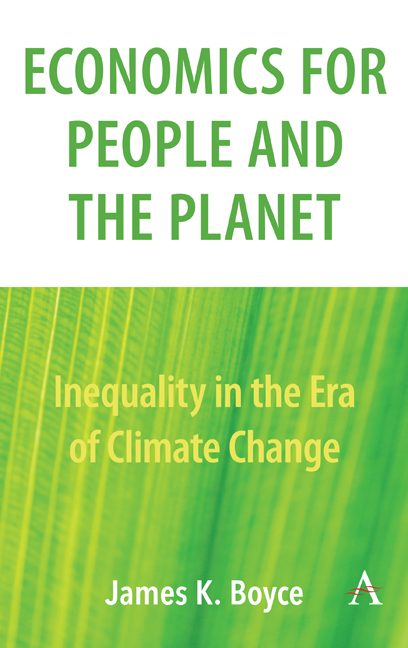Book contents
- Frontmatter
- Contents
- List of Illustrations
- Acknowledgements
- Part I Rethinking Economics and the Environment
- Part II Environmental Injustice
- Chapter 9 Inequality and the Environment
- Chapter 10 Clean Air for All
- Chapter 11 Letter from Flint
- Chapter 12 Let Them Drink Pollution?
- Chapter 13 Letter from Delhi
- Chapter 14 Mapping the Environmental Riskscape
- Chapter 15 Measuring Pollution Inequality
- Chapter 16 Cleaning the Air and Cooling the Planet
- Part III Climate Policy
- Notes
- Publication History
- Index
Chapter 11 - Letter from Flint
from Part II - Environmental Injustice
Published online by Cambridge University Press: 12 February 2019
- Frontmatter
- Contents
- List of Illustrations
- Acknowledgements
- Part I Rethinking Economics and the Environment
- Part II Environmental Injustice
- Chapter 9 Inequality and the Environment
- Chapter 10 Clean Air for All
- Chapter 11 Letter from Flint
- Chapter 12 Let Them Drink Pollution?
- Chapter 13 Letter from Delhi
- Chapter 14 Mapping the Environmental Riskscape
- Chapter 15 Measuring Pollution Inequality
- Chapter 16 Cleaning the Air and Cooling the Planet
- Part III Climate Policy
- Notes
- Publication History
- Index
Summary
Flint, Michigan's transformation from industrial wonder to urban disaster shows the perils of elevating consumption above citizenship.
It began on 30 December 1936, at Fisher Body No. 1 in Flint, Michigan: workers occupied General Motors factories, launching one of the landmark struggles in US labour history. A Women's Emergency Brigade brought them food; when the police tried to drive out the strikers with tear gas, the women broke the windows to give them fresh air. After 44 bitter winter days, the sit-down strike forced GM to recognize their union, the United Auto Workers.
It was not an accident that Flint was the scene of this historic battle. One hundred years ago, when the city boasted the largest factory in the world–a Buick plant–the people of Flint elected a socialist mayor. But GM founding partner Charles S. Mott won two years later, campaigning on a platform whose first point was ‘Only men who are successful at business should run city affairs.’
The US auto industry pioneered not only mass production but also mass consumption. ‘The American citizen's first importance to his country is no longer that of citizen but that of consumer,’ the pro-business Flint Journal editorialized in 1924. ‘Consumption is the new necessity.’
By the early 1950s, when I was a baby and my parents moved there, Flint's workers were earning the highest industrial wages in the nation. In an exhibit called ‘Flint and the American Dream’, the city's Sloan Museum today displays the household belongings of a typical auto worker of that era: the kitchen appliances, formica countertops, chrome-and-vinyl furniture, the lawn mower and charcoal grill of my childhood.
Flint's American dream is now a distant memory. Starting in the 1970s, one auto plant after another shut down, a downward slide vividly portrayed in Michael Moore's 1989 film Roger & Me. In the 1981 recession, Flint had the highest unemployment rate in the country. Today, despite the fact that Flint's population has fallen to less than 60 per cent of what it was in 1960, the city's unemployment rate still ranks in the top 50 among the country's 372 metropolitan areas. In the neighbourhood of company-built bungalows where I lived as a toddler, the pavements are cracked, the median strips are overgrown with weeds, and abandoned, burnt-out houses decay among the surviving homes.
- Type
- Chapter
- Information
- Economics for People and the PlanetInequality in the Era of Climate Change, pp. 53 - 56Publisher: Anthem PressPrint publication year: 2019



